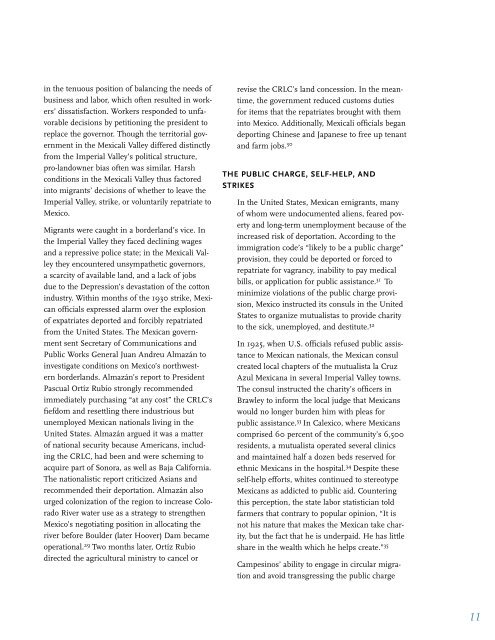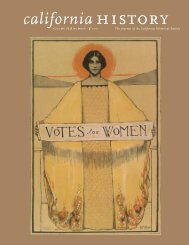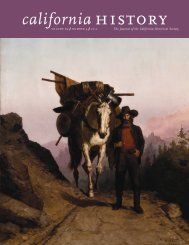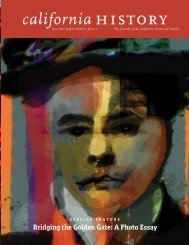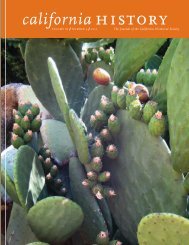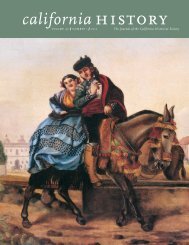Volume 88, Number 4 - California Historical Society
Volume 88, Number 4 - California Historical Society
Volume 88, Number 4 - California Historical Society
You also want an ePaper? Increase the reach of your titles
YUMPU automatically turns print PDFs into web optimized ePapers that Google loves.
in the tenuous position of balancing the needs of<br />
business and labor, which often resulted in workers’<br />
dissatisfaction. Workers responded to unfavorable<br />
decisions by petitioning the president to<br />
replace the governor. Though the territorial government<br />
in the Mexicali Valley differed distinctly<br />
from the Imperial Valley’s political structure,<br />
pro-landowner bias often was similar. Harsh<br />
conditions in the Mexicali Valley thus factored<br />
into migrants’ decisions of whether to leave the<br />
Imperial Valley, strike, or voluntarily repatriate to<br />
Mexico.<br />
Migrants were caught in a borderland’s vice. In<br />
the Imperial Valley they faced declining wages<br />
and a repressive police state; in the Mexicali Valley<br />
they encountered unsympathetic governors,<br />
a scarcity of available land, and a lack of jobs<br />
due to the Depression’s devastation of the cotton<br />
industry. Within months of the 1930 strike, Mexican<br />
officials expressed alarm over the explosion<br />
of expatriates deported and forcibly repatriated<br />
from the United States. The Mexican government<br />
sent Secretary of Communications and<br />
Public Works General Juan Andreu Almazán to<br />
investigate conditions on Mexico’s northwestern<br />
borderlands. Almazán’s report to President<br />
Pascual Ortíz Rubio strongly recommended<br />
immediately purchasing “at any cost” the CRLC’s<br />
fiefdom and resettling there industrious but<br />
unemployed Mexican nationals living in the<br />
United States. Almazán argued it was a matter<br />
of national security because Americans, including<br />
the CRLC, had been and were scheming to<br />
acquire part of Sonora, as well as Baja <strong>California</strong>.<br />
The nationalistic report criticized Asians and<br />
recommended their deportation. Almazán also<br />
urged colonization of the region to increase Colorado<br />
River water use as a strategy to strengthen<br />
Mexico’s negotiating position in allocating the<br />
river before Boulder (later Hoover) Dam became<br />
operational. 29 Two months later, Ortíz Rubio<br />
directed the agricultural ministry to cancel or<br />
revise the CRLC’s land concession. In the meantime,<br />
the government reduced customs duties<br />
for items that the repatriates brought with them<br />
into Mexico. Additionally, Mexicali officials began<br />
deporting Chinese and Japanese to free up tenant<br />
and farm jobs. 30<br />
The Public Charge, Self-Help, and<br />
Strikes<br />
In the United States, Mexican emigrants, many<br />
of whom were undocumented aliens, feared poverty<br />
and long-term unemployment because of the<br />
increased risk of deportation. According to the<br />
immigration code’s “likely to be a public charge”<br />
provision, they could be deported or forced to<br />
repatriate for vagrancy, inability to pay medical<br />
bills, or application for public assistance. 31 To<br />
minimize violations of the public charge provision,<br />
Mexico instructed its consuls in the United<br />
States to organize mutualistas to provide charity<br />
to the sick, unemployed, and destitute. 32<br />
In 1925, when U.S. officials refused public assistance<br />
to Mexican nationals, the Mexican consul<br />
created local chapters of the mutualista la Cruz<br />
Azul Mexicana in several Imperial Valley towns.<br />
The consul instructed the charity’s officers in<br />
Brawley to inform the local judge that Mexicans<br />
would no longer burden him with pleas for<br />
public assistance. 33 In Calexico, where Mexicans<br />
comprised 60 percent of the community’s 6,500<br />
residents, a mutualista operated several clinics<br />
and maintained half a dozen beds reserved for<br />
ethnic Mexicans in the hospital. 34 Despite these<br />
self-help efforts, whites continued to stereotype<br />
Mexicans as addicted to public aid. Countering<br />
this perception, the state labor statistician told<br />
farmers that contrary to popular opinion, “It is<br />
not his nature that makes the Mexican take charity,<br />
but the fact that he is underpaid. He has little<br />
share in the wealth which he helps create.” 35<br />
Campesinos’ ability to engage in circular migration<br />
and avoid transgressing the public charge<br />
11


